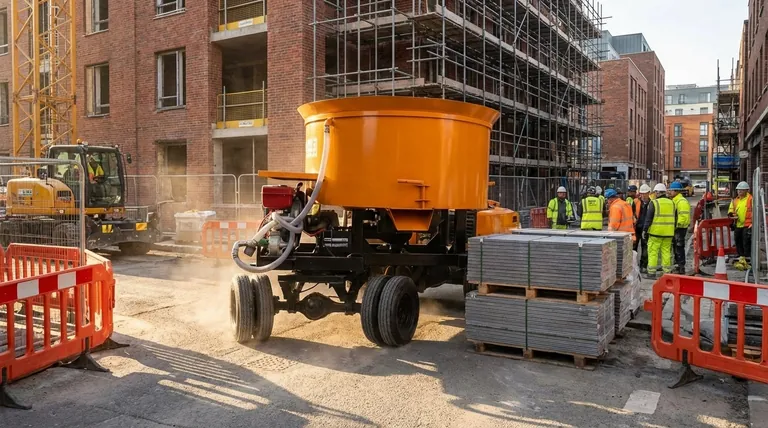At its core, four-wheel steering transforms a self-loading concrete mixer from a useful machine into an indispensable tool for complex job sites. It directly addresses the primary operational challenge: maneuvering a heavy vehicle in confined, obstacle-rich environments with precision and safety.
The true benefit of four-wheel steering is not just about turning tighter; it's about unlocking the self-loading mixer's fundamental promise of being a complete, mobile batching plant in spaces where conventional equipment simply cannot operate.

The Core Challenge: Job Site Constraints
A self-loading concrete mixer's value is its ability to combine loading, mixing, and transportation into one vehicle. This makes it ideal for projects where space is at a premium.
The Problem with Conventional Steering
Standard two-wheel steering forces a large turning radius. In a congested construction area, this results in time-consuming multi-point turns, increasing the risk of collision and slowing down the entire workflow.
The Demands of Modern Sites
Modern construction sites, especially in urban areas or for renovation projects, are rarely open and clear. Operators must navigate around other machinery, materials, and personnel in very tight quarters.
How Four-Wheel Steering Solves the Maneuverability Problem
Four-wheel steering fundamentally changes how the machine moves, providing direct solutions to the challenges of a constrained site.
Drastically Reduced Turning Radius
By turning the rear wheels in the opposite direction of the front wheels, the machine can pivot in a much smaller area. This allows it to make turns in a single, fluid motion where a two-wheel steer vehicle could not.
Enhanced Agility and Precision
This system gives the operator precise control to navigate narrow passages and position the mixer perfectly for loading or unloading. The machine feels more nimble and responsive, akin to a much smaller vehicle.
Improved Safety and Reduced Risk
Greater maneuverability directly translates to a safer work environment. The operator can more easily avoid obstacles and personnel, significantly reducing the chances of accidental property damage or injury.
Amplifying the Mixer's Inherent Advantages
Four-wheel steering isn't just an isolated feature; it acts as a multiplier for the self-loading mixer's primary benefits.
Maximizing On-Site Efficiency
Less time spent on complicated positioning maneuvers means more time spent on the core tasks of mixing and pouring concrete. This directly increases productivity and helps keep projects on schedule.
Reducing Operator Workload
A machine that is easier and less stressful to operate reduces fatigue and allows the single operator to focus on other critical functions, like managing the mix and the pour. This enhances the value of its one-person operation design.
Unlocking True Versatility
With the ability to access the most difficult-to-reach parts of a job site, a four-wheel steering mixer becomes a far more versatile asset, capable of tackling a wider range of projects that would be impossible for less agile equipment.
Understanding the Trade-offs
While highly beneficial, it's important to understand the implications of this advanced system.
Increased Mechanical Complexity
A four-wheel steering system involves more components than a standard two-wheel setup. This can translate to a higher initial purchase price and potentially more maintenance points over the life of the machine.
Operator Adjustment
While ultimately making the job easier, operators accustomed to conventional steering will require a brief period to familiarize themselves with the machine's different handling characteristics to use it effectively.
Making the Right Choice for Your Goal
The necessity of four-wheel steering depends entirely on your typical working environment.
- If your primary focus is projects on open, spacious sites: The full benefit of four-wheel steering may not be critical, and a standard model could be a cost-effective solution.
- If your primary focus is urban construction, renovations, or complex industrial sites: Four-wheel steering is an essential feature that will directly impact your project's speed, safety, and overall efficiency.
- If your primary focus is maximizing safety and reducing operational risk: The enhanced control and precision offered by four-wheel steering provide an invaluable safety advantage in any environment.
Ultimately, choosing a mixer with four-wheel steering is an investment in operational agility and on-site effectiveness.
Summary Table:
| Benefit | Impact on Operation |
|---|---|
| Reduced Turning Radius | Enables tight turns in confined spaces, eliminating multi-point maneuvers. |
| Enhanced Agility & Precision | Provides nimble control for navigating narrow passages and precise positioning. |
| Improved Safety | Lowers risk of collisions and injuries by avoiding obstacles with greater ease. |
| Increased Efficiency | Saves time on maneuvering, allowing more focus on mixing and pouring tasks. |
Maximize your project's efficiency and safety with a GARLWAY self-loading concrete mixer equipped with advanced four-wheel steering. Designed for construction companies and contractors working in complex, space-constrained environments, our mixers offer unparalleled maneuverability to tackle urban construction, renovations, and industrial sites. Let us help you enhance on-site productivity and reduce operational risks. Contact GARLWAY today to learn more about our robust construction machinery solutions, including winches, concrete mixers, and batching plants!
Visual Guide

Related Products
- Portable Cement Mixer with Lift Concrete Machine
- Belle Mixer Drum Self Loading Mortar Mixers JS3000
- Portable Electric Concrete Mixer Machine for Cement Mixing
- Portable Concrete Mixer Machine Equipment for Mixing Concrete
- Ready Mixer Machine for Construction Ready Mix Machinery
People Also Ask
- How do self-loading concrete mixers benefit construction in rural or remote areas? Achieve Total On-Site Concrete Independence
- How should the engine of a self-loading concrete mixer be started? Ensure Safe & Efficient Operation
- In what types of construction projects are self-loading concrete mixers particularly useful? Boost Efficiency in Remote & Tight Sites
- What are the key considerations for the long-term sustainability of self-loading concrete mixers?
- How can material buildup or adhesion in a self-loading concrete mixer be prevented? Essential Strategies for Efficiency
















